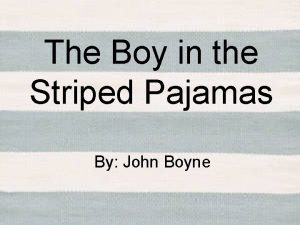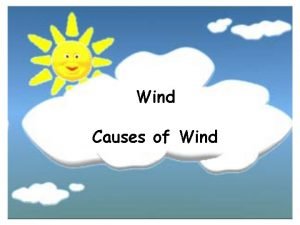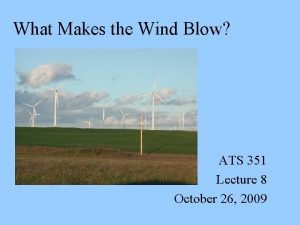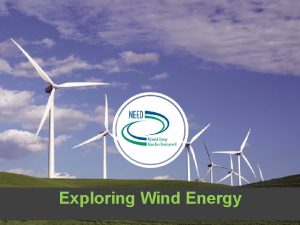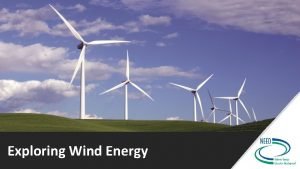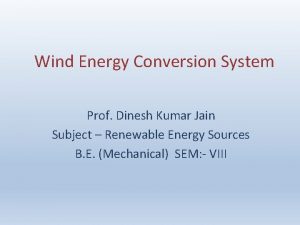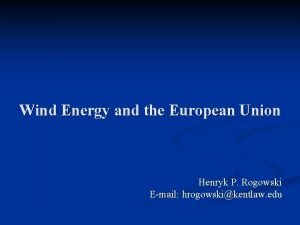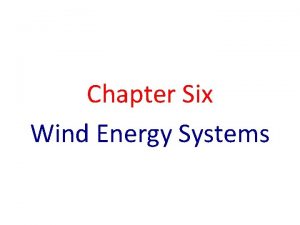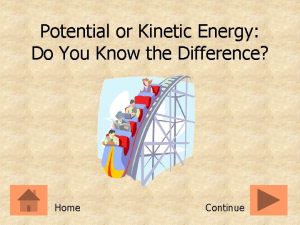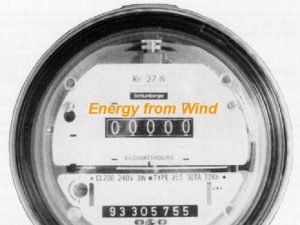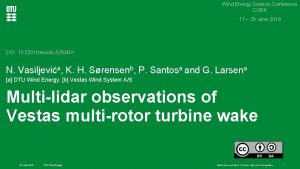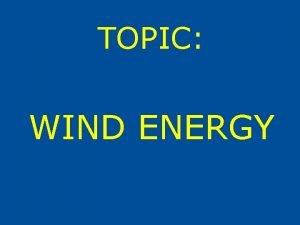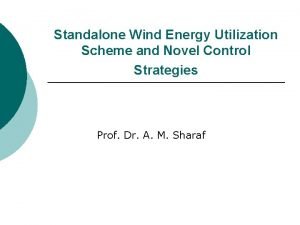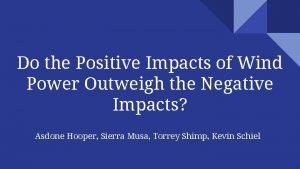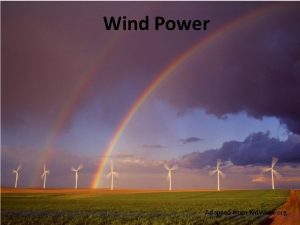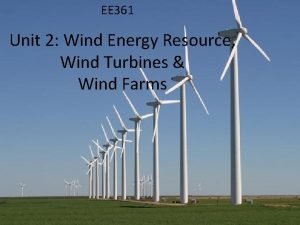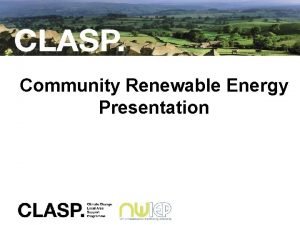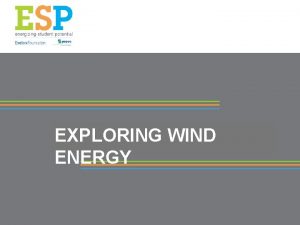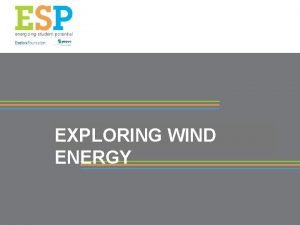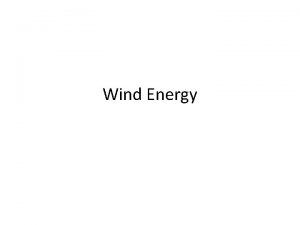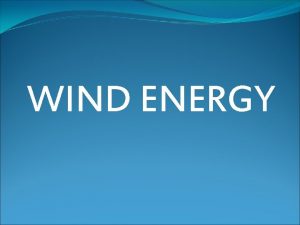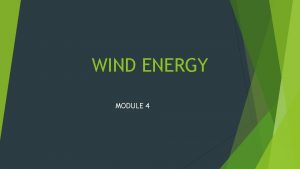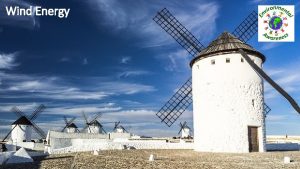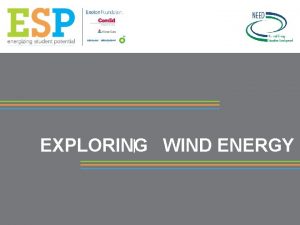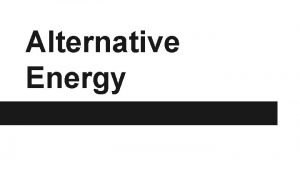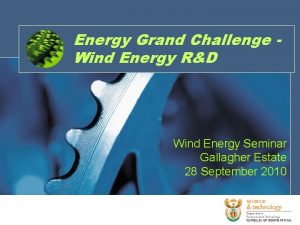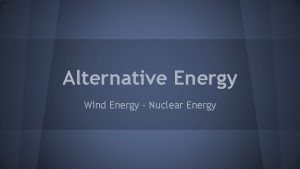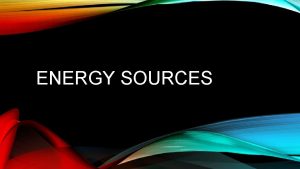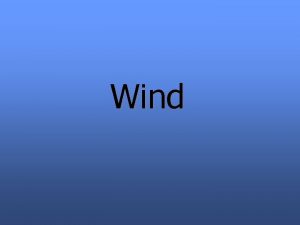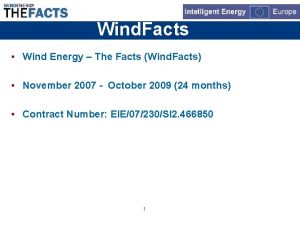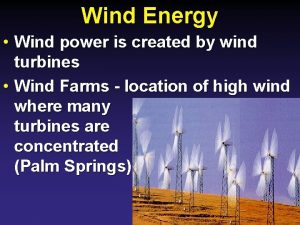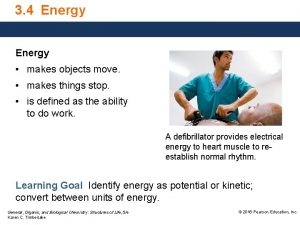Exploring Wind Energy What Makes Wind Exploring Wind































- Slides: 31

Exploring Wind Energy

What Makes Wind Exploring Wind - 2020 ©The NEED Project

Global Wind Patterns Exploring Wind - 2020 ©The NEED Project

History of Wind Energy 5000 BC 500 -900 AD Sailboats used on the First windmills Nile indicate the power developed in Persia of wind 1888 Charles F. Brush used windmill to generate electricity in Cleveland, OH Early 1900 s Windmills in CA pumped saltwater to evaporate ponds 1993 US Wind. Power developed first commercial variable-speed wind turbine 1300 AD First horizontal-axis windmills in Europe 1941 In VT, Grandpa’s Knob turbine supplies power to town during WWII 2004 Electricity from wind generation costs 3 to 4. 5 cents per k. Wh Exploring Wind - 2020 ©The NEED Project 1850 s Daniel Halladay and John Burnham build Halladay Windmill; start US Wind Engine Company 1979 First wind turbine rated over 1 MW began operating 2016 Block Island Offshore Wind Farm was brought online (US’s first offshore wind farm) Late 1880 s Thomas O. Perry conducted 5, 000 wind experiments; starts Aermotor Company 1985 CA wind capacity exceeded 1, 000 MW 2017 Wind power provided over 20% of renewable energy used in US

Why Wind Energy? • Clean, zero emissions • NOx, SO 2, CO 2 • Air quality, water quality • Climate change • Reduce fossil fuel dependence • Energy independence • Domestic energy—national security • Renewable • No fuel-price volatility Exploring Wind - 2020 ©The NEED Project

Renewable Electric Capacity Worldwide US DOE, EERE 2017 Renewable Energy Data Book Exploring Wind - 2020 ©The NEED Project

U. S. Electricity Generation from Renewables US DOE, EERE 2017 Renewable Energy Data Book Exploring Wind - 2020 ©The NEED Project

Top Wind Power Producing States, 2019 Rank State 1 Texas 2 Oklahoma 3 Iowa 4 Kansas 5 California

Annual Installed U. S. Wind Power Capacity US DOE, EERE 2017 Renewable Energy Data Book Exploring Wind - 2020 ©The NEED Project

Installed Wind Capacities |1999 -Present 1999 Total: 2, 500 MW Exploring Wind - 2020 ©The NEED Project 2018 Total: 96, 487 MW

Wind Energy Potential by State Exploring Wind - 2020 ©The NEED Project

U. S. Wind Resource Map Exploring Wind - 2020 ©The NEED Project

Transmission Challenges Exploring Wind - 2020 ©The NEED Project

Source: Global Wind Energy Council

Why Such Growth? …costs are low! • Increased Turbine Size • R&D Advances • Manufacturing Improvements 1979 40 cents/k. Wh 2000 4 -6 cents/k. Wh Exploring Wind - 2020 ©The NEED Project 2004 3 - 4. 5 cents/k. Wh 2017 Less than 5 cents/k. Wh

Modern Wind Turbines can be categorized into two classes based on the orientation of the rotor. Exploring Wind - 2020 ©The NEED Project

Vertical-Axis Turbines Advantages • Omni-directional • accepts wind from any direction • Components can be mounted at ground level • ease of service • lighter weight towers • Can theoretically use less materials to capture the same amount of wind Exploring Wind - 2020 ©The NEED Project Disadvantages • • • Rotors generally near ground where wind is poorer Centrifugal force stresses blades Poor self-starting capabilities Requires support at top of turbine rotor Requires entire rotor to be removed to replace bearings Overall poor performance and reliability

Horizontal-Axis Wind Turbines Small (<10 k. W) Intermediate(10 -250 k. W) • Homes • Farms • Remote Applications (e. g. , water pumping, Telecom sites, ice making) Large (250 k. W-2+ MW) • Central Station Wind Farms • Distributed Power • Schools Exploring Wind - 2020 ©The NEED Project • Village Power • Hybrid Systems • Distributed Power

Large Wind Turbines Common Utility-Scale Turbines • 328’ base to blade • Each blade is 112’ • 200 tons total • Foundation 20’ deep • Rated at 1. 5 -2 megawatts • Supply power to about 500 homes Exploring Wind - 2020 ©The NEED Project

Wind Turbine Components


Installation of Wind Turbines Exploring Wind - 2020 ©The NEED Project

Wind Turbine Perspective Workers Blade 112’ long Nacelle 56 tons Tower 3 sections Exploring Wind - 2020 ©The NEED Project

Wind Farms Exploring Wind - 2020 ©The NEED Project

Offshore Wind Farms The first U. S. offshore wind farm is Block Island Wind Farm, located off the coast of Rhode Island. This five-turbine, 30 megawatt wind farm began operation in 2016. Photo of Block Island Wind Farm Exploring Wind - 2020 ©The NEED Project

Residential Wind Systems and Net Metering AC to Grid Wind Turbine AC Utility Meter AC Electrical Circuits DC Voltage Input Inverter & Interconnects Exploring Wind - 2020 ©The NEED Project AC Voltage Input Main Utility Breaker Panel

Potential Impacts and Issues • • • Property Values Noise Visual Impact Land Use Wildlife Impact Properly siting a wind turbine can mitigate many of these issues. Exploring Wind - 2020 ©The NEED Project

Impacts of Wind Power: Noise

Wildlife Impacts Top Common Human-Caused Threats to Birds 3, 000, 000 Median/Avg. Estimated 2, 500, 000 2, 400, 000 2, 000, 000 1, 500, 000 2400 M 1, 000, 000 599, 000 500, 000 214, 500, 000 6, 600, 000 25, 500, 000 Collision Communication Towers Collision - Electrical Lines 0 Cats Building Glass [VALUE] Collision - Vehicles Collision - Land-based Wind Turbines Hazard Type Source: U. S. Fish and Wildlife · U. S. only, as of 2017 Exploring Wind - 2020 ©The NEED Project

For More Information The NEED Project www. need. org info@need. org 1 -800 -875 -5029 Energy Information Administration U. S. Department of Energy www. eia. gov Exploring Wind - 2020 ©The NEED Project

NEED IS SOCIAL! Let’s be Facebook (@needproject) official! Events, energy news, and more! Follow us on Twitter (@NEED_Project)! We share the latest energy news from around the country. Follow us on Instagram (@theneedproject) and check out photos from workshops and when we go live for hands-on experiments. Follow us on Pinterest and pin ideas to use in your classroom. www. pinterest. com/needproject Subscribe to our You. Tube channel. Hands-on energy lesson tutorials, interviews with energy career professionals, & more! www. youtube. com/user/needproject NEED is social! ©The NEED Project
 The boy in the striped pajamas blonde soldier
The boy in the striped pajamas blonde soldier Indirect forms of solar energy
Indirect forms of solar energy What makes wind blow
What makes wind blow Warm air aloft is normally associated with
Warm air aloft is normally associated with What makes wind
What makes wind What makes wind
What makes wind Rushing wind blow through this temple
Rushing wind blow through this temple Energy energy transfer and general energy analysis
Energy energy transfer and general energy analysis Energy energy transfer and general energy analysis
Energy energy transfer and general energy analysis Food web words
Food web words Raumschotkurs
Raumschotkurs Components of wind energy conversion system ppt
Components of wind energy conversion system ppt Conclusion of europe
Conclusion of europe Disadvanteges of solar power
Disadvanteges of solar power Wind energy the facts
Wind energy the facts Is a flag blowing in the wind potential or kinetic energy
Is a flag blowing in the wind potential or kinetic energy Energy and change grade 7
Energy and change grade 7 Swept area method
Swept area method Wind energy science conference 2019
Wind energy science conference 2019 Characteristics of wind energy
Characteristics of wind energy Wind energy
Wind energy Positive effects of wind energy
Positive effects of wind energy Kidwind.org
Kidwind.org Ee-361
Ee-361 Wind energy presentation
Wind energy presentation Wind energy module e
Wind energy module e Wind energy presentation
Wind energy presentation Section 2 describing energy
Section 2 describing energy Potential energy in spring
Potential energy in spring Primary energy and secondary energy
Primary energy and secondary energy What is commercial energy source
What is commercial energy source Gibbs free energy vs standard free energy
Gibbs free energy vs standard free energy
